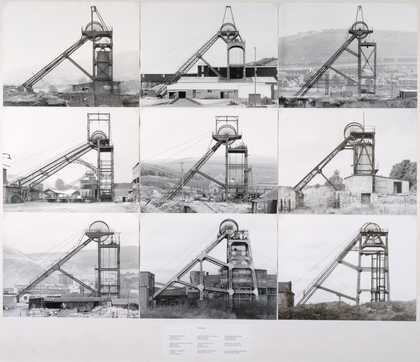
Bernd Becher and Hilla Becher
Pitheads (1974)
Tate
Who are╠²they?
Hilla Becher was a German artist born in 1931 in Siegen, Germany. She was one half of a photography duo with her husband Bernd Becher. For forty years, they photographed disappearing industrial architecture around Europe and North╠²America.
They won the Erasmus Prize in 2002 and Hasselblad Award in 2004 for their work and roles as photography professors at the art academy .
How did they become a╠²duo?
They began collaborating together in 1959 after meeting at the Kunstakademie D├╝sseldorf in 1957. Bernd originally studied painting and then typography, whereas Hilla had trained as a commercial photographer. After two years collaborating together, they╠²married.
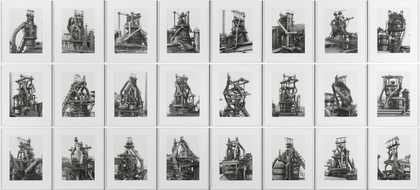
Bernd Becher and Hilla Becher
Blast Furnaces (1969ŌĆō95)
Tate
What did they╠²photograph?
Industrial structures including water towers, coal bunkers, gas tanks and factories. Their work had a documentary style as their images were always taken in black and white. Their photographs never included╠²people.
They exhibited their work in sets or typologies, grouping of several photographs of the same type of structure. The are well known for presenting their images in grid╠²formations.╠²
Was it even photography in the first╠²place?
Well technically yes, but their work has also been referred to as sculpture. The Bechers called the subjects of their photographs ŌĆśanonymous sculpturesŌĆÖ, and they produced a successful photobook of the same title in╠²1970.
In 1990, they received an award at the Venice Biennale not for photography, but sculpture, due to their ability to illustrate the sculptural properties of╠²architecture.
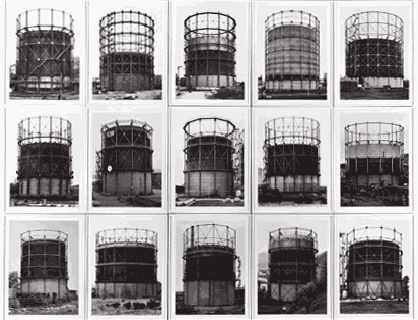
Bernd and Hilla Becher
Gas-holders Germany, Belgium, France, Britain, USA, 1966ŌĆō93
Each 40 x 30╠²cm
All photographs courtesy Bernd and Hilla╠²Becher
What were the common╠²themes?
Overlooked beauty and the relationship between form and function. Both subjects addressed the effect of industry on economy and the╠²environment.
What were their key╠²works?
Their first photobook Anonymous Sculptures was published in 1970 and is their most well-known body of work. The title is a nod to Marcel DuchampŌĆÖs readymades and indicates that the BecherŌĆÖs referred to industrial buildings as found╠²objects.
The book consisted of an encyclopaedic inventory of industrial structures including kilns, blast furnaces and gas-holders categorised into sections (the pot, the oven, the chimney, the winch, the pump, and the╠²laboratory.)
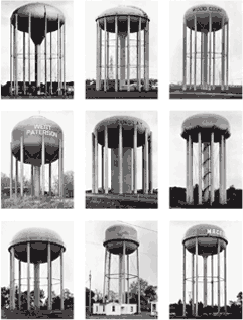
Bernd and Hilla Becher
Water Towers USA, 1988
Black and white photographs
Each 40 x 30╠²cm
Collection John Aniello
All photographs courtesy Bernd and Hilla╠²Becher
What was their╠²legacy?
They were often labelled as conceptual artists and influenced minimalist and conceptual artists like Ed Ruscha, Carl Andre and Douglas Huebler.
As professors of The Dusseldorf School of Photography, they influenced a generation of German photographers who were their students (including Andreas Gursky, Candida H├Čfer, Thomas Ruff and Thomas Struth.)
What do the critics╠²say?
The Bechers approached photography the way a botanist might approach the cataloguing of flora and fauna
Sean OŌĆÖHagan, the╠²GuardianThey are the lines on the face of the world. The photographs are portraits of our history. And when the structures have been demolished and grassed over, as though they were never there, the pictures remain.
Michael Collins, The Long Look╠²I was struck as always by the underlying sense of loss and melancholy that emanates from these photographs: you are looking at a lost world, however soul-destroying that world was for those who had to live and work in it.
Sean OŌĆÖHagan, the╠²Guardian
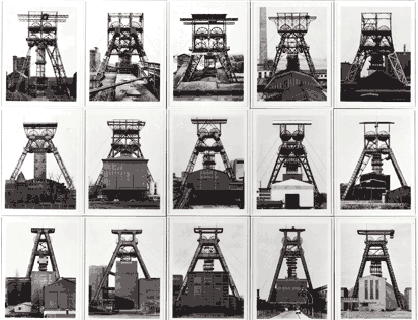
Bernd and Hilla Becher
Winding towers Germany, Belgium, France, 1965ŌĆō98
Each 40 x 30╠²cm
All photographs courtesy Bernd and Hilla Becher
Becher in╠²quotesŌĆ”
The question ŌĆśis this a work of art or not?ŌĆÖ is not very interesting for us.
Instant Expert, American╠²PhotoBy placing several cooling towers side by side something happened, something like tonal music; you donŌĆÖt see what makes the objects different until you bring them together, so subtle are their differences.
Hilla Becher obituary, the╠²GuardianWe photographed water towers and furnaces because they are honest. They are functional, and they reflect what they do - that is what we liked. A person always is what s/he wants to be, never what s/he is. Even an animals usually plays a role in front of the camera.
